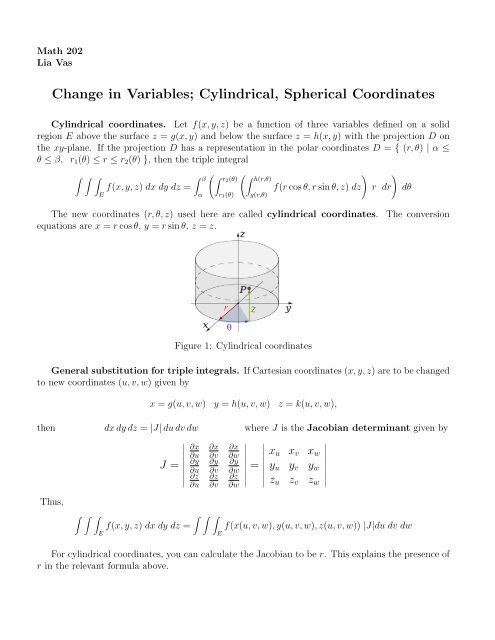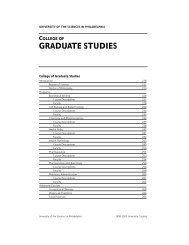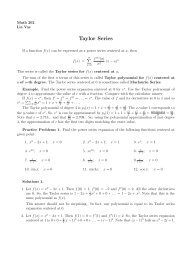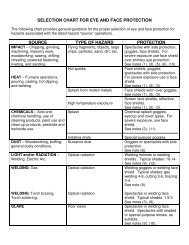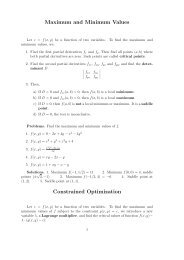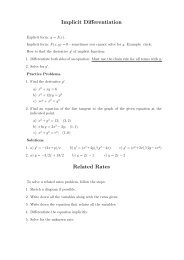Change in Variables; Cylindrical, Spherical Coordinates
Change in Variables; Cylindrical, Spherical Coordinates
Change in Variables; Cylindrical, Spherical Coordinates
- No tags were found...
You also want an ePaper? Increase the reach of your titles
YUMPU automatically turns print PDFs into web optimized ePapers that Google loves.
Math 202Lia Vas<strong>Change</strong> <strong>in</strong> <strong>Variables</strong>; Cyl<strong>in</strong>drical, <strong>Spherical</strong> Coord<strong>in</strong>atesCyl<strong>in</strong>drical coord<strong>in</strong>ates. Let f(x, y, z) be a function of three variables def<strong>in</strong>ed on a solidregion E above the surface z = g(x, y) and below the surface z = h(x, y) with the projection D onthe xy-plane. If the projection D has a representation <strong>in</strong> the polar coord<strong>in</strong>ates D = { (r, θ) | α ≤θ ≤ β, r 1 (θ) ≤ r ≤ r 2 (θ) }, then the triple <strong>in</strong>tegral∫ ∫ ∫Ef(x, y, z) dx dy dz =∫ ( β ∫ (r2 (θ) ∫ h(r,θ)αr 1 (θ)g(r,θ)f(r cos θ, r s<strong>in</strong> θ, z) dz)r dr)dθThe new coord<strong>in</strong>ates (r, θ, z) used here are called cyl<strong>in</strong>drical coord<strong>in</strong>ates.equations are x = r cos θ, y = r s<strong>in</strong> θ, z = z.The conversionFigure 1: Cyl<strong>in</strong>drical coord<strong>in</strong>atesGeneral substitution for triple <strong>in</strong>tegrals. If Cartesian coord<strong>in</strong>ates (x, y, z) are to be changedto new coord<strong>in</strong>ates (u, v, w) given byx = g(u, v, w) y = h(u, v, w) z = k(u, v, w),then dx dy dz = |J| du dv dw where J is the Jacobian determ<strong>in</strong>ant given byThus,∫ ∫ ∫EJ =∂x∂u∂y∂u∣∂z∂u∂x∂v∂y∂v∂z∂v∫ ∫ ∫f(x, y, z) dx dy dz =E∂x∂w∂y∂w∂z∣∂w=∣∣x u x v x ∣∣∣∣∣∣∣∣wy u y v y wz u z v z wf(x(u, v, w), y(u, v, w), z(u, v, w)) |J|du dv dwFor cyl<strong>in</strong>drical coord<strong>in</strong>ates, you can calculate the Jacobian to be r. This expla<strong>in</strong>s the presence ofr <strong>in</strong> the relevant formula above.
General substitution for double <strong>in</strong>tegrals. For double <strong>in</strong>tegrals, if Cartesian coord<strong>in</strong>ates(x, y) are to be changed to new coord<strong>in</strong>ates (u, v) given by x = g(u, v) y = h(u, v), then dxdy =|J|dudv where the Jacobian determ<strong>in</strong>ant J is given by∣ ∂x ∂x ∣Then∫ ∫DJ =∣∂u∂y∂u∂v∂y∂v∫ ∫f(x, y) dx dy =D∣ ∣ ∣∣∣∣ ∣ = x u x ∣∣∣∣ v.y u y vf(x(u, v), y(u, v)) |J|du dvCheck that the polar coord<strong>in</strong>ates x = r cos θ and y = r s<strong>in</strong> θ have the Jacobian determ<strong>in</strong>ant J = r.This is the reason why the substitution with polar coord<strong>in</strong>ates yields∫ ∫∫ ∫f(x, y)dxdy = f(r cos θ, r s<strong>in</strong> θ) r dr dθ.D<strong>Spherical</strong> coord<strong>in</strong>ates. Besides cyl<strong>in</strong>drical coord<strong>in</strong>ates, another frequently used coord<strong>in</strong>ates fortriple <strong>in</strong>tegrals are spherical coord<strong>in</strong>ates. <strong>Spherical</strong> coord<strong>in</strong>ates are mostly used for the <strong>in</strong>tegralsover a solid whose def<strong>in</strong>ition <strong>in</strong>volves spheres.If P = (x, y, z) is a po<strong>in</strong>t <strong>in</strong> space and O denotes the orig<strong>in</strong>, let• r denote the length of the vector −→ OP = 〈x, y, z〉, i.e. the distance of the po<strong>in</strong>t P = (x, y, z)from the orig<strong>in</strong> O. Thus,x 2 + y 2 + z 2 = r 2 ;• θ be the angle between the projection of vector −→ OP = 〈x, y, z〉 on the xy-plane and the vector−→ i (positive x axis); and• φ be the angle between the vector −→ OP and the vector −→ k (positive z-axis).With this notation, spherical coord<strong>in</strong>ates are (r, θ, φ). The conversion equations arex = r cos θ s<strong>in</strong> φ y = r s<strong>in</strong> θ s<strong>in</strong> φ z = r cos φThe Jacobian determ<strong>in</strong>ant for the spherical coord<strong>in</strong>ates is r 2 s<strong>in</strong> φ. Thus,dx dy dz = r 2 s<strong>in</strong> φ dr dφ dθ.Practice problems.Figure 2: <strong>Spherical</strong> coord<strong>in</strong>ates
1. Evaluate the triple <strong>in</strong>tegrala) ∫ ∫ ∫ E√x2 + y 2 dx dy dz where E is the region that lies <strong>in</strong>side the cyl<strong>in</strong>der x 2 + y 2 = 16and between the planes z = −5 and z = 4.b) ∫ ∫ ∫ E 2 dx dy dz where E is the solid that lies between the cyl<strong>in</strong>ders x2 +y 2 = 1 x 2 +y 2 = 4and between the xy-plane and the plane z = x + 2.c) ∫ ∫ ∫ E (x2 + y 2 + z 2 ) dx dy dz where E is the unit ball x 2 + y 2 + z 2 ≤ 1.d) ∫ ∫ ∫ E z dx dy dz where E is the region between the spheres x2 + y 2 + z 2 = 1 andx 2 + y 2 + z 2 = 4 <strong>in</strong> the first octant.2. F<strong>in</strong>d the volume of the solid enclosed by the paraboloids z = x 2 + y 2 and z = 36 − 3x 2 − 3y 2 .3. F<strong>in</strong>d the volume of the solid enclosed by the paraboloids z = x 2 + y 2 and z = 18 − x 2 − y 2 .4. Use the given transformation to evaluate the <strong>in</strong>tegral.a) ∫ ∫ D (3x+4y) dx dy where D is the region bounded by the l<strong>in</strong>es y = x, y = x−2, y = −2x,and y = 3 − 2x. The substitution x = 1/3(u + v), y = 1/3(v − 2u) transforms the regionto a rectangle 0 ≤ u ≤ 2 and 0 ≤ v ≤ 3.b) ∫ ∫ D xy dx dy where D is the region <strong>in</strong> the first quadrant bounded by the curves y = x,y = 3x, y = 1/x, and y = 3/x. The substitution x = u/v, y = v transforms the region<strong>in</strong>to a region with bounds 1 ≤ u ≤ 3 and √ u ≤ v ≤ √ 3u.c) ∫ ∫ D xy dx dy where D is the region <strong>in</strong> the first quadrant bounded by the curves y = x,y = 3x, y = 1/x, and y = 3/x. The substitution x = √ u, y = √ uv transforms the regionv<strong>in</strong>to a square 1 ≤ u ≤ 3 and 1 ≤ v ≤ 3.5. F<strong>in</strong>d the volume of the ellipsoid x 2 /4 + y 2 /9 + z 2 /25 = 1 by us<strong>in</strong>g the transformation x = 2u,y = 3v z = 5w.Solutions.1. a) Use cyl<strong>in</strong>drical coord<strong>in</strong>ates. The <strong>in</strong>terior of the circle x 2 +y 2 = 16 can be described by 0 ≤ θ ≤2π and 0 ≤ r ≤ 4. The bounds for z are given by z = −5 and z = 4. ∫ ∫ ∫ √E x2 + y 2 dx dy dz =∫ 2π ∫ 4 ∫ 4√0 0 −5 r2 r dr dθ dz = ∫ 2π0 dθ ∫ 40 r2 dr ∫ 4−5 dz = 2π 64 (4 + 5) = 384π.3b) The region between the circles x 2 + y 2 = 1 x 2 + y 2 = 4 has 0 ≤ θ ≤ 2π and 1 ≤ r ≤ 2.The bounds for z are xy-plane z = 0 and the plane z = x + 2 which <strong>in</strong> polar coord<strong>in</strong>ateshas the equation z = r cos θ + 2. Thus, us<strong>in</strong>g the cyl<strong>in</strong>drical coord<strong>in</strong>ates, ∫ ∫ ∫ E 2 dx dy dz =∫ 2π ∫ 2 ∫ r cos θ+20 1 0 2r dr dθ dz = ∫ 2π0 dθ ∫ 21 2r dr (r cos θ + 2) = ∫ 2π0 dθ (2 r3 cos θ + 3 2r2 )| 2 1 =∫ 2π0 dθ ( 14 cos θ + 6) = 12π.3c) Us<strong>in</strong>g spherical coord<strong>in</strong>ates, 0 ≤ θ ≤ 2π, 0 ≤ φ ≤ π, and 0 ≤ r ≤ 1. ∫ ∫ ∫ E x2 + y 2 +z 2 dx dy dz = ∫ 2π02π(2) 1 = 4π.5 5∫ π0∫ 10 r2 r 2 s<strong>in</strong> φdr dθ dφ = ∫ 2π0 dθ ∫ π0 s<strong>in</strong> φdφ ∫ 10 r4 dr = 2π(− cos φ)| π 0 r5 5 |1 0 =d) Use spherical coord<strong>in</strong>ates. S<strong>in</strong>ce the region is <strong>in</strong> the first octant, 0 ≤ θ ≤ π and 0 ≤ φ ≤ π.2 2The bounds for r are determ<strong>in</strong>ed by the radii of the spheres, so 1 ≤ r ≤ 2. ∫ ∫ ∫ E z dx dy dz =∫ π/2 ∫ π/2 ∫ 20 0 1 r cos φ r2 s<strong>in</strong> φdr dθ dφ = ∫ π/20 dθ ∫ π/20 cos φ s<strong>in</strong> φdφ ∫ 21 r3 dr = π 1 r 42 2 4 |2 1 = 15π16
2. Use cyl<strong>in</strong>drical coord<strong>in</strong>ates. The paraboloids have the equations z = x 2 + y 2 = r 2 and z =36 − 3x 2 − 3y 2 = 36 − 3r 2 . The first is the lower z-bound and the second is the upper. Thebounds for θ are 0 ≤ θ ≤ 2π. The paraboloids <strong>in</strong>tersect <strong>in</strong> a circle. The projection of the circle<strong>in</strong> xy-plane determ<strong>in</strong>es the r-bounds. The <strong>in</strong>tersection is when 36 − 3r 2 = r 2 ⇒ 36 = 4r 2 ⇒9 = r 2 ⇒ r = 3 (negative solution is not relevant). Thus, the r-bounds are 0 ≤ r ≤ 3.The volume is V = ∫ ∫ ∫ dxdydz = ∫ 2π02π(18r 2 − r 4 )| 3 0 = 2π(162 − 81) = 162π.∫ 30∫ 36−3r 2r 2r dr dθ dz = ∫ 2π0 dθ ∫ 30 r dr(36 − 3r2 − r 2 ) =3. Very similar to the previous problem. The z-bounds are x 2 +y 2 = r 2 ≤ z ≤ 18−x 2 −y 2 = 18−r 2 .The bounds for θ are 0 ≤ θ ≤ 2π. The <strong>in</strong>tersection of paraboloids is when 18 − r 2 = r 2 ⇒18 = 2r 2 ⇒ 9 = r 2 ⇒ r = 3 (negative solution is not relevant). Thus, the r-bounds are0 ≤ r ≤ 3. The volume is V = ∫ ∫ ∫ dxdydz = ∫ 2π0r 2 − r 2 ) = 2π(9r 2 − r4 2 )|3 0 = 2π(81 − 81) = 81π.2∣ x4. a) Calculate the Jacobian J = u x ∣∣∣∣ v=∣ y u y v ∣∫ 2 ∫ 30 0 (u + v + 4(v − 2u)) 1du dv = 1 3 3 31(6 + 9 + 12 − 16) = 11 3 3∣ xb) The Jacobian is J = u x ∣∣∣∣ v=∣ y u y v ∣∫ 31 udu ln v|√ √3uu= ∫ 31 udu ln √ 3 = ln √ 3 u2c) The Jacobian is J =∫ 3 ∫ 31 1√ uv√ uv1du dv = ∫ 3 ∫ 32v 1 1∫ 301/3 1/3−2/3 1/3∫ 18−r 2r 2∫ 2 v20 (uv + + 4v2 − 8uv2 6 3 )|3 0 du = 1 31/v −u/v 20 1r dr dθ dz = ∫ 2π0 dθ ∫ 30 r dr(18 −∣ = 1 + 2 = 1. ∫ ∫ 9 9 3 D (3x + 4y) dx dy =∫ 20 (3u + 9 + 6 − 8u) du =2∣ = 1. ∫ ∫ v D xy dx dy = ∫ 312 |3 1 = 4 ln √ 3 = 2 ln 3 = 2.197∣ x u x ∣∣∣∣ 1v=2 √ − √ uuv 2 √ √ √v ∣ y u y 3vv ∣2 √ uu 2 √ ∣vu2vdu dv =u24 |3 1 ln v| 3 1 = 2 ln 3 = 2.197∫ √ 3u√ uuv 1 du dv =v v= 1 + 1 = 1 . ∫ ∫ 4v 4v 2v D xy dx dy =5. The substitution x = 2u, y = 3v and z = 5w converts the ellipsoid <strong>in</strong>to a sphere of radius2 0 01. The Jacobian of the substitution is J =0 3 0= 30. Thus, the volume is equal to∣ 0 0 5 ∣V = ∫ ∫ ∫ dx dy dz = ∫ ∫ ∫ 30 du dv dw. Use the spherical coord<strong>in</strong>ates now. The bounds are0 ≤ θ ≤ 2π, 0 ≤ φ ≤ π, and 0 ≤ r ≤ 1 and the Jacobian is r 2 s<strong>in</strong> φ. Thus, the volumeis V = ∫ ∫ ∫ 30 r 2 s<strong>in</strong> φ dr dφ dθ = 30 ∫ 2π0 dθ ∫ π0 s<strong>in</strong> φ dφ ∫ 10 r2 dr = 30 2π (− cos φ)| π 0 r3 3 |1 0 =120π 1 = 40π.3


